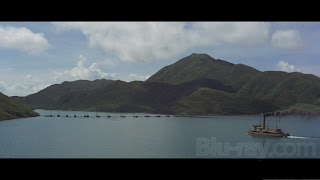 Generally considered his masterpiece, City Lights stars Chaplin as his iconic Tramp character. He is certainly at the height of his immense talent. Exercising complete creative control, Chaplin also directed the film, wrote the screenplay, produced it, did the editing, and composed the effective score. Essentially a love story, Chaplin unfolds the tale with some of the most hilarious comedy sequences ever filmed.
Generally considered his masterpiece, City Lights stars Chaplin as his iconic Tramp character. He is certainly at the height of his immense talent. Exercising complete creative control, Chaplin also directed the film, wrote the screenplay, produced it, did the editing, and composed the effective score. Essentially a love story, Chaplin unfolds the tale with some of the most hilarious comedy sequences ever filmed. Audiences today have little appreciation for the genius of Chaplin. It's on view here in his unparallelled comedic timing and inventive physicality, and through his uncanny ability to evoke deep feelings from the viewer without dialog. Chaplin made this film four years after talkies revolutionized the film industry and altered what audiences came to expect from films. His two great contemporaries, Buster Keaton and Harold Lloyd, had already abandoned silent films, and for all intense and purposes retired with the advent of sound.
It was a big risk. After all, the nation was in the midst of the Depression and understandably, audiences were increasingly discerning as to how they spent entertainment dollars. But Chaplin was an immensely confident man. He believed in his ability as an artist able to transcend the age. The result is evident in every scene.
We are introduced to the Tramp in the opening sequence. A mayor is giving a speech before a civic crowd. Chaplin uses a series of unintelligible high-pitched squeaks and sounds to represent the typical bloated political speech. It sounds reminiscent of the noises used for adult speech in 1960's Charlie Brown Peanuts television specials. Someone pulls the cord to lower the canvas cover to unveil a hidden monument. The Tramp is asleep in the arms of one of the figures. The crowd hollers for him to remove himself, and when he tries, his pants get stuck on the sword of another, reclining figure. As the band strikes up the National Anthem, the vagrant removes his hat and places it on his heart.
Several other sight gags will likely draw a chuckle from the viewer: the Tramp stops to admire the figure of a naked woman in a window, stepping on and off a freight elevator in the sidewalk as it alternatively rises and falls to gain better perspective; most of several bottles of champagne end up in his pants; and at a party, he mistakes a man's bald head for a plate of food. One of the best takes place during a sequence with the drunken millionaire as the two friends share dinner at a nightclub. While eating a plate of spaghetti, a curly streamer from the ceiling falls onto Charlie's plate and winds up in his mouth. He chews and chews but can't seem to come to the end of this "noodle."
 |
| A long noodle. |
What follows is one of Chaplin's best set pieces, the boxing match. The winner will earn $50. It is choreographed to perfection, with Charlie using the referee as a shield, bouncing in a funny shuffle to keep the man between himself and his opponent. The music Chaplin overlays to the scene works beautifully. Charlie lands several punches, gets the bell cord stuck around his neck, and even vaults off the ropes a few times to catapult himself into the stomach of his foe, but eventually he is knocked unconscious and loses the fight.
Like all great silent films, there is much in a closeup. Chaplin and the other actors amuse the audience with some wonderful expressions of fear, false courage, and disdain. Hank Mann plays the Tramp's ring opponent. Nearly always listed as "uncredited," Mann would have a long film career. Here he is wonderfully dour.
 |
| The famous fight scene. |
The final moments are special, and rank with the great emotional endings in all of film. Chaplin demonstrates that he was more than a mere director of film, he was a poet, able to weave pathos and humor together to produce magic. It is several months later. Released from jail, the tramp encounters the girl; with sight restored, she is now the owner of a prosperous flower shop. She takes pity on the strange vagrant and offers him a coin and a flower. Their hands touch, she recognizes the feel of his, and it suddenly dawns on her who is standing before her, her mysterious benefactor, not a rich man but a homeless one.
Virginia Cherill plays the blind flower girl. She is lovely and later married Cary Grant.
Films competing with City Lights that year for audiences included two horror classics: Dracula and Frankenstein; two classic gangster movies: The Public Enemy and Little Caesar; and that year's Best Oscar-winning film and epic Western, Cimarron. Still, City Lights impressively was the fourth highest grossing film.
City Lights was named to the National Film Registry in 1971, the third induction class. It should have been in the inaugural group.
























